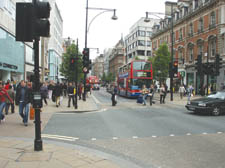| |

Oxford Street has been hit by the economic downturn and rise of shopping centres elsewhere |
Let’s not lose sight of the ‘living city’
Plans for Oxford Street must not neglect the needs of the area’s residents, says Ian Wilder
OVER the past five years there has been an orchestrated campaign of criticism by major local commercial interests about the state of Oxford Street, especially the east end of the street.
The truth is that the historic east end is not really any worse than the west end of the street. Not only that but the eastern end has a very rich history and many of its buildings are of architectural interest.
On the ground floor there are some unappealing shops and shop fronts but so there so are on the western end of the street, as on high streets all over the country.
The fabric of the city must be constantly improved. The planning inspector who presided over the complaints regarding the Oxford Street unitary development plan when it was reviewed a few years ago stated that it is not sufficient for Westminster City Council to merely maintain the existing infrastructure, it must make efforts to improve it.
But the wants of the landlords and the needs of local residents are diametrically opposed. The commercial interests want to increase the number of shoppers coming into the West End daily by tens of thousands if not more.
After they have finished shopping, these shoppers go and find local food and drink entertainment, some of which would inevitably end up causing damage to the amenity of residents.
There have been constant references in the press about major retail developments in the east end of Oxford Street. No doubt the commercial interests are trying their best but their plans would have been good for the 1950s and 60s, not for the 21st century.
The ideas of the commercial interests seem unsustainable. Whatever they get, they will want more; for instance, they have convinced the city council to allow two car free shopping days. They will not be satisfied with that and we can expect more demands from them over the coming years.
One current bright spot is that tourism is flourishing in the West End and that is precisely what the area should be focusing on. Many entertainment and shopping offerings in the West End today are very expensive and are ideal for the tourist market.
What then is the solution? First, we have to recognise that we are in a different world than we have been in for the past 20 years. Not only because of the economic mess we are in but also because other parts of London have seen exciting new shopping and residential development. It is simply no longer necessary for many Londoners to have to come to the West End and put up with all the parking and traffic restrictions and other very heavy costs of a West End trip when they can go to more or less the same stores locally.
Often forgotten by all those so-called experts on the West End is that there are residential communities north and south of Oxford Street, at both ends.
The solution to the perceived problems of the historic eastern end of Oxford Street is to encourage more residential development in the northern and southern hinterlands, such as in Fitzrovia and in Soho.
More residents will create their own local demand for speciality stores but this demand will be sustainable.
Further, local residents will complain if local conditions are not satisfactory and this will end up saving the city council valuable costs.
Policing costs will also be reduced, as will cleansing and licensing enforcement.
If you agree with my views then please email me at: efield. westminster.gov.uk
Here are some other action you can take:
l Encourage your Local Amenity Society to monitor closely all planning consents in the Fitzrovia and Soho areas.
l Challenge council planning officers to ensure that sites are either given over to residential development or that residential units form a material part of these developments.
This may sound like a wing and a prayer but the leader of the city council in his speech to the council in March used the words “living city” no less than 12 times. It was a brilliant speech containing ideas that will, if they are followed through, change for the better the entire structure of the east end of Oxford Street. That is very meaningful support and the leader has clearly got right behind this concept and should be congratulated for this kind of recognition of the way forward.
But it needs the active and continuous support of local residents and Local Amenity Societies.
The leader’s speech opens the door to a whole new future for the West End, especially Fitzrovia and Soho. It must be supported.
•
|
 |
|
|
 |
| |
| |